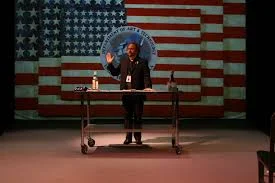Bare Life Study #1
In 2005, Coco Fusco coordinated and documented a military performance in front of the US Consulate in Sao Paulo, Brazil. The photos that comprise the Bare Life Study #1 explore contemporary military scenarios as intercultural encounters. 50 young drama students participated by dressing in typical orange inmate uniforms, shackled, and scrubbed the streets with a toothbrush while Fusco assumed the posture of authority over them- bullhorn in hand. The various images show the inmates in straight rows, heads bowed, walking to the US Consulate. Other images revealed the inmates on all fours scrubbing the asphalt of the street with cars and onlookers in the distance.
The performance premiered at VideoBrasil Festival of Electronic Art and Performance, Sao Paulo. Later, images were collected and shown in an exhibit at MC, Los Angeles. The photo collection that document Bare Life Study #1 was displayed in the room adjacent to Operation Atropos, a film by Fusco. Operation Atropos explored the weaponization of female sexuality by the US military. Between the two exhibits was a desk with Fusco’s Human Resource Exploitation Manual For Female Interrogators stacked on top.
Image courtesy of artist's website- cocofusco.com
The year before Fusco led the Bare Life Study performance, the media was filled with the recently revealed tortures of prisoners in Abu Ghraib, in the secret prisons of Bagram in Afghanistan. Photographs taken in Abu Ghraib highlighted the use of femininity as a control weapon and humiliation. Fusco strategically recreated this humiliation and abuse when assuming the position of power over detainees and forcing them to scrub the streets with their only possession, a toothbrush. The dramatization of the work is seen by the impossible task the prisoners were given. A force of 50 prisoners could not possibly keep a public street clean with only a toothbrush.
Much of Fusco’s research for Bare Life Study #1 , Operation Atropos, and Human Resource Exploitation Manual For Female Interrogators stemmed from an ongoing study on military interrogation (Fusco, 2005).
““The four years that I spent working on military interrogation enabled me to bring a conversation about the war into the realm of art, and into the realm of performance. The pieces became ways for me to open up discussions about performative practices that are neither traditional theatre nor art, but that contain elements of both.””
Image courtesy of artist's website- cocofusco.com
Operation Atropos is a film that documents Fusco and 5 other women’s experiences while studying former US military interrogators through a training course.
““The training involved an immersive simulation of being prisoners of war: we were ambushed, captured, stripped searched, thrown in the pen and subject to several interrogations. Afterwards, in a classroom scenario, the tactics used against us were analyzed and we were taught to do what had been done to us.””
Interestingly, Fusco noted that the interrogators she studied considered themselves to be great actors. During an interrogation, the interrogator’s goal is to make the prisoner say exactly what they want to hear. Not only are the interrogators great actors, but script writers. Additionally, the interrogators mentioned the use of different characters they embody when interrogating different people. They are constantly adapting the techniques to fit the prisoner they are interrogating. Thus, the act of interrogation can be a performance. Even the prisoners are dressed in costume and given a new name, or more likely a number.
Image courtesy of artist's website- cocofusco.com
Coco Fusco used her work to exploit the US military for the actions we rarely hear of, as well as spark conversation.
“Bare Life study was my way to open a Pandora’s box, to get people to see what we were doing.””
Similarly, artist Jenny Holzer’s work Redaction Paintings, a 112 page essay, focused on declassified US documents related to Abu Ghraib and the interrogation procedure. Holzer slightly altered the documents by magnification, then created silkscreen reproductions. Many of the documents were blacked out in areas by the government for unknowable security reasons before their release. Holzer further blacked out portions of the text on each page before publishing them.
““Sometimes it’s a relief to come to the pages that are wholly blacked out because then, for at least a page or so, you don’t have to read what was there. The redaction paintings include many pages that are almost completely blacked out.””
Image courtesy of Cheim and Read- http://www.cheimread.com/publications/jenny-holzer-redaction-paintings/gallery/images
Though Fusco and Holzer focused on the released photographs and documents related to Abu Ghraib, their artistic approach and end goal varied. Fusco’s performance was meant to expose the war on terror and interrogation methods the US military were using. The weaponization of femininity and exploitation of interrogation were not covered up but dramatized and recreated. Holzer found the documentation so unsettling, she focused on blackening out the indigestible truth, which was sometimes entire pages. Differences in approach do not affect the relationship between the bodies of work. Each artist’s work uniquely portrays the unsettling reality that was happening at Abu Ghraib.









